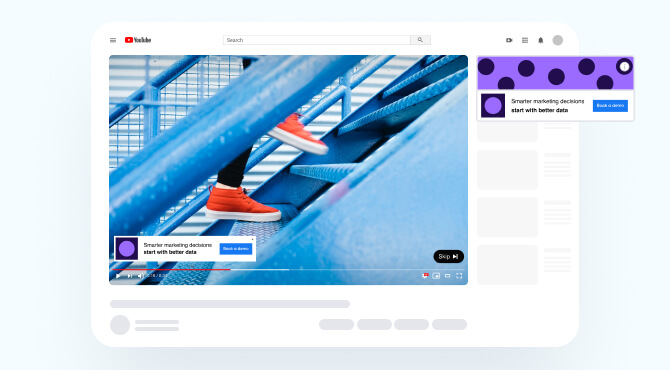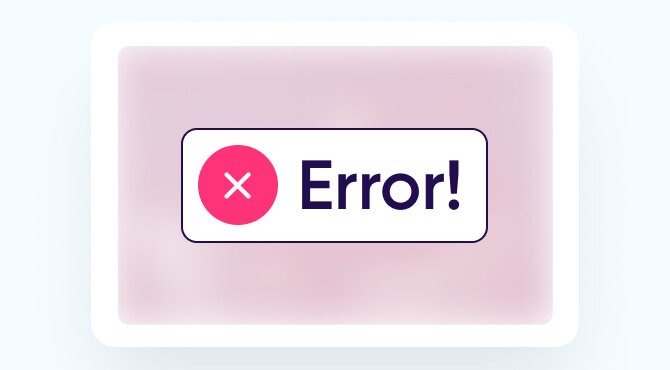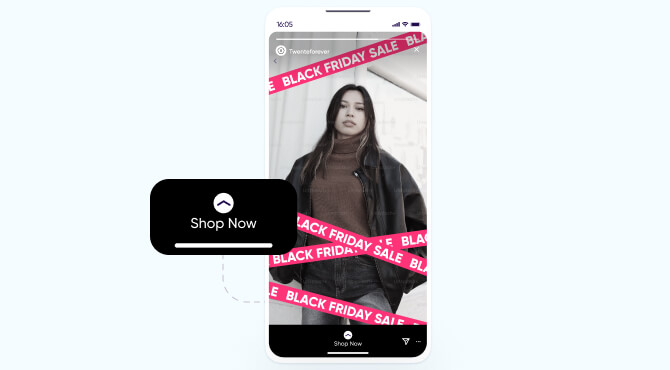
In-stream ads
In-stream ads are brief video ads that play within other videos on platforms like YouTube, Facebook, and Instagram. They show up before, in the middle, or after the main video, grabbing the viewer’s attention when they are most focused on the content.
What are in-stream ads?
In-stream ads are short, snappy advertisements placed within popular social media video content. They’re timed as pre-roll, mid-roll, or post-roll (we’ll explain these terms in just a minute), ensuring your message hits users when they’re most engrossed in the content for maximum impact.

In-stream ads go beyond just YouTube videos, seamlessly blending into content like Facebook livestreams and Instagram Stories to grab your attention as you scroll.
Note that these ads are intentionally non-skippable for a brief period — usually 5-30 seconds. That might sound short, but with your audience so focused and primed to engage, it’s a real opportunity to make your mark.
Types of in-stream ads
In-stream ads can be broken into the following three categories:
1 — Linear ads
The most common form of in-stream ads, linear ads disrupt the main video content. Taking up the entire video playing space, they’re called “linear” because they play sequentially with the content — similar to commercial breaks on traditional TV, which come between and during shows.
Here are three types of linear video ads:
- Pre-roll: Before your video content kicks in, pre-roll ads make their entrance, lasting for 15, 30, or 60 seconds. They offer a tried-and-true method for brands to boost awareness, recollection, and purchase consideration. While users might have the option to skip these ads, the key is to craft engaging content in the initial moments to ensure a positive and lasting impression.
- Mid-roll: Shown right in the middle of your video content, mid-roll video ads are the shorter versions of pre-roll ads. Capitalizing on the fact that users have already invested time in watching the video, mid-roll ads have lower abandonment rates and higher completion rates. This makes them a good option for brands aiming to ensure their entire ad gets the spotlight – if only for a few seconds.
- Post-roll: Post-roll ads play as the grand finale at the end of your video content. Despite being the least used in-stream format, these can be remarkably effective. Users, having watched their intended video, are more likely to take the next step and click through to a page.
2 – Non-linear ads
Non-linear video ads, also known as overlay ads, appear on top of playing content without obstructing or interrupting it. This means they’re less intrusive than linear ads, allowing viewers to continue watching content while the ad is active.
These non-linear ads can manifest as follows:
- Overlay banner: This non-linear ad format appears discreetly at the top or bottom of the screen during video playback. It adds a touch of promotion without disrupting the primary content, providing a subtle yet effective advertising tool.

- Overlay text: A non-intrusive companion to video content, overlay text appears during video playback, sharing valuable insights or information without interrupting the main narrative. This format enhances the viewer’s understanding without detracting from the core message.
- Branded canvas unit: The branded canvas unit transforms the screen into a captivating visual canvas. It takes the form of an L-shaped banner that briefly shrinks the video being played, allowing you to showcase your brand in an artistic and memorable manner. This simulates the ad experience from over-the-top (OTT) and connected TV (CTV) spaces on the web.
3 – Companion ads
Companion ads deviate from the strict definition of in-stream as they don’t appear directly within the video stream. Instead, they appear beside the video in the form of an image, text, or rich media ad, positioned outside the video player.

Despite their placement, companion ads play a crucial role in improving brand visibility and combating banner blindness. They’re often used along with linear or non-linear in-stream ads, hence the name “companion ads.”
In-stream ads vs. out-stream ads
We’re focusing on in-stream ads here, but there’s another, similar term you may have heard: out-stream ads. These play in non-video mobile content, for example when you’re scrolling through a newspaper article.
Here’s a table highlighting the main differences between in-stream ads and out-stream ads:
| Aspect | In-stream video ads | Out-stream video ads |
| Placement | These pop up before (pre-roll), during (mid-roll), or after (post-roll) the main video content, seamlessly integrating with the viewing experience. | These appear in various non-video formats, making them more versatile in placement. Options include in-feed ads within articles, in banner ads, and interstitial ads between page content. |
| User experience | More disruptive. These ads play within the video content, requiring viewers to watch them before they can continue with the main video. | Less intrusive. Out-stream ads don’t rely on existing video content and auto-play when in view, but users can scroll past them if they want to continue browsing without interruption. |
| Levels of engagement | Expect higher engagement rates. In-stream ads shine here, since viewers are already watching video content, making them more likely to pay attention to the ads. | Expect lower engagement rates. Out-stream ads may not grab as much attention, since viewers might not be as focused on the ad content while going about their online activities. |
| Content control | Marketers have a bit less control over where their in-stream ads appear. It all depends on the content of the host video. | Marketers enjoy more control with out-stream ads. They’re not tied to specific video content, giving advertisers the freedom to choose where their ads appear. |
How to choose between in-stream and out-stream ads
The key differences between in-stream and out-stream ads boil down to where they pop up and how they blend into the user’s experience.
In-stream ads cozy up within video content, creating a bit more interruption, while out-stream ads showcase their flexibility in various formats, offering a smoother user journey.
When it comes to engagement, in-stream ads take the lead, capturing attention within playback content. However, out-stream ads, though (slightly) less engaging, provide more control to advertisers over where their content appears.
Final verdict: Choosing between the two advertising formats depends on your advertising goals and who you’re trying to reach.
Benefits of using in-stream ads
Next, let’s review why you should include in-stream ads as part of your digital marketing campaign:
- Readiness: In-stream ads capitalize on the fact that viewers are actively seeking video content. Whether they’ve just clicked on a video, are in the middle of one, or have just finished watching, viewers are already in a video-watching mindset. This makes it more likely they’re sitting comfortably, with audio on, ready to engage with your content.
- High compatibility with OTT and CTV advertising: In-stream ads work well with services like OTT and CTV. This means that when people are enjoying shows or movies on these platforms, they can also see your ads. Not only can you achieve a wide reach this way, but you can use demographic, behavioral, or geographic data to get your ads in front of the most relevant audience segments for your brand.
- Motivation: Viewers of in-stream ads, particularly non-skippable pre-rolls and mid-rolls, have a motivation to continue watching: to return to the original content. This creates a level of engagement and motivation to see the ad through. Also, the option to skip the ad after a brief period offers a balance, so you don’t alienate viewers who want the freedom to click away.
- Attention: By momentarily interrupting their browsing routine, in-stream ads compel viewers to pay attention — even if it’s just for a few seconds — helping you break through the online noise and capture the audience’s focus. Unsurprisingly, the average social media ad click-through rate worldwide is 1.2%.
- Affordability: If you’re working with a tight budget, in-stream ads are a smart choice. Depending on the chosen keywords, the cost of views can be low, making it a cost-effective option for businesses with limited money. Plus, if you’re working on a cost-per-completed-view basis, you won’t waste your budget on viewers who don’t watch to the end.
- Customization: In-stream ads offer marketers great customization flexibility. You get to decide if you want to make people watch the whole ad or let them click away after a certain time, like five seconds or one minute. So, you can customize your ad strategy to fit exactly what you’re trying to achieve with your campaign.
Challenges of in-stream ads
Despite the undeniable advantages, in-stream ads aren’t a perfect paid social advertising solution. Here are some of their biggest drawbacks:
- Intrusive user experience: In-stream ads, while disruptive enough to capture attention, can sometimes be perceived as intrusive. Consider it a flip side of their disruptive nature: viewers may find the interruption jarring, leading to potential negative reactions and unfavorable brand perception.
- Ad-compatible video player requirement: In-stream ads have a technical dependency: an ad-compatible video player for seamless integration. As a result, you have to ensure your chosen platforms and publishers support the necessary infrastructure for delivering the ad.

- Restricted availability: Some platforms may not support in-stream ad formats, restricting the diversity of channels available for advertisers to reach their target audience. This restriction may limit the impact of the ad, affecting the success of your advertising strategy.
- High cost per mille (CPM): Compared to other advertising formats, in-stream ads often come with a higher CPM, with advertisers paying a significant amount for every thousand impressions. This can strain advertising budgets, making it challenging for smaller businesses or those with limited resources to leverage this format effectively.
- Difficulty in aligning ads with playback content: A critical aspect of in-stream advertising is aligning the ad with the theme or tone of the video content. It’s a pivotal factor in sustaining viewer interest. To get this right, you need to plan carefully and understand both the target audience and the broader content landscape.
Best practices for in-stream ads
Creating and executing an effective in-stream ad campaign requires a nuanced approach. To set you on the right path, consider the following in-stream advertising best practices:
1 — Make engaging ads with swift impact
Consumers often click the “Skip” button within seconds. This means that time is of the essence and you need to get your message across before the viewer has the option to skip.
How do you do that? Create ads that swiftly convey your message. Opt for action-packed scenes or concise product explanations, steering clear of unnecessary jargon. Be sure to highlight the benefits you offer, even if the allotted video time is limited to 30 or 60 seconds.
2 — Ensure it’s viewer-centric
In the brief span you have, focus your in-stream ad on the viewer.
Address them directly to create a personalized experience — use the word “YOU” as frequently as possible. You can also use the phrase “so you can” as a powerful psychological language pattern, to keep the video benefit-focused and tailored for the viewer.
For instance, structure your message around addressing a viewer’s pain point, showcasing how they can achieve a desired outcome. This personalized strategy resonates well, especially since viewers are actively seeking answers during their brief engagement with the ad.
3 — Differentiate with visual and auditory cues
Leverage visual and auditory strategies to make your ads memorable. Start by promptly displaying your brand logo and maintaining a consistent visual identity with colors and large fonts.
If your target audience is already familiar with your brand, consider using established script structures for added resonance. For example, if your brand typically uses a humorous tone or storytelling style in your ads, continuing this approach will resonate with viewers already familiar with your advertising style.
Grab attention by incorporating vibrant colors, catchy music or phrases, and engaging movement — this trifecta will hold the viewer’s attention and keep them interested, ensuring your ad makes an impact.
4 — Use simple and actionable CTAs
Use clear CTA (call to action) messages in the primary text, URL, and video content to encourage action. Avoid using vague language — instead of saying something like “Click here to find out more,” guide the viewer on what will happen and the steps to take. Even a straightforward ‘Shop Now’ works when placed in context:

5 — Add captions for greater accessibility
Subtitles and captions are crucial for viewers who watch without sound or have hearing impairments. Make sure to upload your video subtitles as .srt files for accuracy and to avoid transcription mistakes. This ensures a seamless viewing experience that’s accessible to a broader audience.
6 — Foster a sense of intimacy
Use camera tricks in your in-stream ads to build an emotional connection with your audience. For instance, you can crop in when featuring characters to fill the screen and engage viewers. Maintaining eye contact throughout the video is another excellent tactic to create a personal conversation feel, rather than a commercial presentation.
Key takeaways
- In-stream ads help cut through the online noise and prompt action. They seamlessly integrate with content, playing before, during, or after streaming videos.
- In-stream ads come in two main formats: linear and non-linear. Linear ads disrupt main video content and include pre-roll, mid-roll, and post-roll ads. Non-linear ads, also known as overlay ads, appear without interrupting the content and include overlay banners, overlay text, and branded canvas units.
- Contrast in-stream ads with out-stream ads, which appear in non-video content. These give advertisers more control over placement, but because they’re less disruptive they tend to achieve lower engagement than in-stream formats.
- In-stream ads capitalize on viewer readiness and motivation, providing high compatibility with OTT and CTV advertising. They’re attention-grabbing, cost-effective, and offer customization flexibility for marketers with tight budgets.
- Despite benefits, in-stream ads can be intrusive for viewers, prompting them to skip whenever they can. Other challenges include the need for special video players, higher costs, platform restrictions, and difficulties aligning ads with content.
- In-stream ads work best when you grab attention fast: use distinctive visuals and sounds, and get your message across as early as possible. Focus on the viewer by talking to them directly and addressing their pain points, and remember to include a clear CTA and accessibility features.



